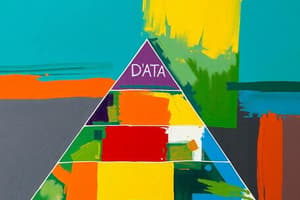Podcast
Questions and Answers
What does DIKW stand for?
What does DIKW stand for?
Data, Information, Knowledge, Wisdom
Define data.
Define data.
Data is a collection of facts in a raw or unorganized form such as images, audio, video clips, numbers, letters, or characters.
What is numeric data?
What is numeric data?
Data represented in the form of numbers.
What is string data?
What is string data?
What is graphical data?
What is graphical data?
What is the smallest unit of data in the data hierarchy?
What is the smallest unit of data in the data hierarchy?
What is a byte?
What is a byte?
What are fields in the context of data hierarchy?
What are fields in the context of data hierarchy?
What is a record in data hierarchy?
What is a record in data hierarchy?
What are files in data hierarchy?
What are files in data hierarchy?
What is a database?
What is a database?
Why are databases important to healthcare?
Why are databases important to healthcare?
What is a data warehouse?
What is a data warehouse?
What are the three states of digital data?
What are the three states of digital data?
What is data at rest?
What is data at rest?
What is data in transit?
What is data in transit?
What is data processing?
What is data processing?
What is a data processing cycle?
What is a data processing cycle?
Which of the following is a type of data processing that involves human intervention?
Which of the following is a type of data processing that involves human intervention?
Which type of data processing involves the use of a computer?
Which type of data processing involves the use of a computer?
Which type of data processing requires data to be processed in a small stipulated time period (real time)?
Which type of data processing requires data to be processed in a small stipulated time period (real time)?
Which type of data processing is described as an efficient way of processing high volumes of data?
Which type of data processing is described as an efficient way of processing high volumes of data?
What are the four basic activities involved in the data processing cycle?
What are the four basic activities involved in the data processing cycle?
What is the input stage in the data processing cycle?
What is the input stage in the data processing cycle?
What is the processing stage in the data processing cycle?
What is the processing stage in the data processing cycle?
What happens during the output stage of the data processing cycle?
What happens during the output stage of the data processing cycle?
What happens during the storage stage of the data processing cycle?
What happens during the storage stage of the data processing cycle?
Define information.
Define information.
What is a Hospital Information System?
What is a Hospital Information System?
What is a Nursing Information System?
What is a Nursing Information System?
Define knowledge.
Define knowledge.
What are Clinical Decision Support Systems (CDSS)?
What are Clinical Decision Support Systems (CDSS)?
Describe expert systems
Describe expert systems
Define wisdom.
Define wisdom.
Flashcards
What is Data?
What is Data?
A collection of facts in a raw or unorganized form. Includes images, audio, video clips, numbers, letters, or characters.
Numeric Data
Numeric Data
Data represented in the form of numbers. Includes 0-9 digits, decimal points, and +/– signs.
String Data
String Data
A sequence of characters that may be English alphabets, numbers, or spaces.
Graphical Data
Graphical Data
Signup and view all the flashcards
Bits
Bits
Signup and view all the flashcards
Bytes
Bytes
Signup and view all the flashcards
Fields
Fields
Signup and view all the flashcards
Records
Records
Signup and view all the flashcards
Files
Files
Signup and view all the flashcards
Database
Database
Signup and view all the flashcards
Database
Database
Signup and view all the flashcards
Efficiency in Healthcare Databases
Efficiency in Healthcare Databases
Signup and view all the flashcards
Exchange of Information
Exchange of Information
Signup and view all the flashcards
Monitoring and Improving Healthcare
Monitoring and Improving Healthcare
Signup and view all the flashcards
Assessing Healthcare Quality
Assessing Healthcare Quality
Signup and view all the flashcards
Tracking Healthcare Usage
Tracking Healthcare Usage
Signup and view all the flashcards
Data Warehouse
Data Warehouse
Signup and view all the flashcards
Data at rest
Data at rest
Signup and view all the flashcards
Data in transit
Data in transit
Signup and view all the flashcards
Data in use
Data in use
Signup and view all the flashcards
Data processing
Data processing
Signup and view all the flashcards
Data processing cycle
Data processing cycle
Signup and view all the flashcards
Manual Data Processing
Manual Data Processing
Signup and view all the flashcards
Electronic Data Processing (EDP)
Electronic Data Processing (EDP)
Signup and view all the flashcards
Real Time Processing
Real Time Processing
Signup and view all the flashcards
Batch Processing
Batch Processing
Signup and view all the flashcards
Data Processing Cycle: Input
Data Processing Cycle: Input
Signup and view all the flashcards
Data Processing Cycle: Processing
Data Processing Cycle: Processing
Signup and view all the flashcards
Data Processing Cycle: Output
Data Processing Cycle: Output
Signup and view all the flashcards
Data Processing Cycle: Storage
Data Processing Cycle: Storage
Signup and view all the flashcards
Information
Information
Signup and view all the flashcards
Hospital Information System
Hospital Information System
Signup and view all the flashcards
Nursing Information System
Nursing Information System
Signup and view all the flashcards
Knowledge
Knowledge
Signup and view all the flashcards
Clinical Decision Support Systems (CDSS)
Clinical Decision Support Systems (CDSS)
Signup and view all the flashcards
Expert systems
Expert systems
Signup and view all the flashcards
Wisdom
Wisdom
Signup and view all the flashcards
The Nelson Data to Wisdom Continuum
The Nelson Data to Wisdom Continuum
Signup and view all the flashcards
Study Notes
DIKW
- DIKW stands for Data, Information, Knowledge, and Wisdom.
Topic Outline
- What is Data
- Data Types
- Data Hierarchy
- Databases
- Data Warehouse
- States of Data
- Data Processing
- Types of Processing
- Data Processing Cycle
- Data to Information
- Information
- Knowledge
- Wisdom
- DIKW
- The Nelson Data to Wisdom Continuum
Objective
- Define and differentiate Data, Information, Knowledge and Wisdom
- Categorize data types and data hierarchy
- Discuss databases and data warehouses, and their importance in healthcare
- Elaborate data processes, the types of processes, and the data processing cycle
- Describe the relationship between data to wisdom continuum and database systems
What is Data?
- Data represents a collection of facts in a raw or unorganized form.
- Examples include images, audio, video clips, numbers, letters, or characters.
- Data is raw materials to be processed by a computer.
- Observations and recordings are done to obtain data
Data Types
- Computer-Based Data Types include Numeric Data, Character Data, and Graphical Data.
- Numeric Data represents data in the form of numbers, including digits 0-9, a decimal point (.), +, /, and – sign.
- Character Data includes String Data with a sequence of characters, such as English alphabets, numbers, or spaces like alphabetic data and alphanumeric data.
- Graphical Data represents data like pictures, charts, and maps.
Data Hierarchy
- Data is organized in layers, classified in a hierarchy in computing.
- Each higher level of data consists of one or more items from the lower level.
Data Hierarchy Levels
- Bits are either 0 or 1 and represent the smallest unit of data.
- Bytes consist of eight bits; one byte makes one character.
- Fields represent a combination of bytes.
- Records combine fields related to one person.
- Files are the combination of records, usually related to different subjects.
- A database is a collection of files and the largest collection of data.
Databases
- A database is an organized collection of related data or any record that a practitioner maintains in paper form or on a computer.
- Anything that a medical practitioner collects from a patient forms part of the database, including encounter forms, discharge forms, or any other registries.
Importance of Databases in Healthcare
- Healthcare databases are an important part of running the entire operations that includes labs, finances, patient identification, tracking, billing, payments, among others.
- Efficiency is achieved through well-designed hospital databases by providing relevant information with a click-of-a-button.
- Hospitals exchange healthcare data anytime there is a requirement.
- Database function integration through things like patient identification is important.
- Database systems provide an important way of monitoring and improving the value of healthcare services, resulting in better well-being for patients.
- Quality experts use hospitals' databases to assess healthcare quality.
- Healthcare databases can provide medical providers with an important tool for tracking healthcare use.
- Other uses include assistance with documentation and billing and reduction in medical facility running costs due to less paperwork and clerical staff.
Data Warehouse
- Data Warehouse is a large collection of data imported from several different systems into one database.
- The source of the data includes not only internal data from the institution, but also data from external sources.
Data Warehouse Example
- Patient digital profile that rounds out a full picture of patient health with: patient reported outcomes, 7x24 biometric data, claims data, healthcare encounter data, consumer data, socio economic data, genomics data, epigenetic data, microbiome data, etc., beyond the traditional encounter and beyond the EHR.
States of Data
- There are three states of digital data: data at rest, data in transit, and data in use.
- Data at rest is data that is not being accessed and is stored on a physical or logical medium, such as files stored on file servers, records in databases, documents on flash drives, or hard disks.
- Data in transit is data that travels through an email, web, collaborative work applications, instant messaging, or any type of private or public communication channel.
- Data in use happens when data is opened by one or more applications for its treatment or and consumed or accessed by users.
Data Processing
- Data processing is any operation or set of operations performed upon data, whether or not by automatic means, such as collection, recording, organization, storage, adaptation, or alteration to convert it into useful information.
- Collected data is processed to convert it into useful information repeatedly until the accurate result is achieved, defined as the data processing cycle.
Types of Processing
- Manual Data Processing involves human intervention.
- Electronic Data Processing (EDP) involves processing of data by a computer.
- Real-Time Processing is a continual input, process, and output of data, requiring the data to be processed in a small stipulated time period.
- Batch Processing is an efficient way of processing high volumes of data.
Data Processing Cycle
- The data processing cycle involves four basic activities: Input, Processing, Output, and Storage.
- Input: Collect data is transformed into a form that a computer can understand including the steps verification, coding, and storing.
- Processing is the actual data manipulation with techniques such as classification, sorting, calculation, and summarizing.
- Output represents anything that comes out of a computer after processing, including retrieval, conversion, and communication.
- Storage involves storing the inputted data and processed information for future use, including storage and retrieval activities.
Data to Information
- Processing data transforms it into information, consisting of processed facts with shapes and patterns.
Information
- A collection of data conveys some meaningful idea.
- Data gains significance when collated or organized, thus becoming information.
- Information relates to description, definition, or perspective and answers the questions "what", "who”, “when”, and "where".
- Hospital Information Systems are computer-based software applications integrating many medical, nursing, administrative, and miscellaneous functions of hospitals, by combining computer technology and communications to acquire and integrate financial and clinical data.
- Nursing Information Systems are computer systems that manage clinical data from a variety of healthcare environments and made available in a timely and orderly fashion to aid nurses in improving patient care.
Knowledge
- Knowledge is the appropriate collection of information, obtained when a student memorizes information.
- Knowledge is an organization and processing to convey understanding, experience, and accumulated learning.
- Knowledge comprises strategy, practice, method, or approach and answers the question "how?".
- Clinical Decision Support Systems (CDSS) are computer software tools designed to facilitate decision-making through connecting evidence with patient status.
- CDSS supports decision-making in time-limited circumstances leading to improved patient outcomes.
- Expert systems represent the present and future vanguard of nursing informatics.
- Expert systems use artificial intelligence to model a decision that experts in the field would make.
- Expert systems convey the concept that the computer has made the best decision based on criteria that experts would use.
Wisdom
- Wisdom involves the possession of knowledge such that one can observe patterns of information within data, make intelligent connections between different patterns, and feel the principles which underlie the patterns themselves.
- Computers lack human quality of wisdom.
- Wisdom answers the question "why?".
- NK is nursing knowledge.
- W stands for wisdom.
- IB is the individual nurse's integration and synthesis of nursing knowledge through the cognitive, psychomotor, and affective/spiritual domain of self.
- P represents the breadth and depth of practice.
DIKW
- DIKW progresses from Raw Data to Derived Information, then to Relevant Knowledge, and culminates in Guiding Wisdom.
The Nelson Data to Wisdom Continuum
- The Nelson data to wisdom continuum by Dr. Romana Nelson, depicts movement of data to information to knowledge to wisdom with constant interaction within and across these concepts as well as the environment.
Studying That Suits You
Use AI to generate personalized quizzes and flashcards to suit your learning preferences.




